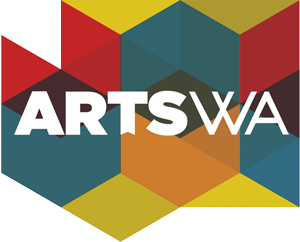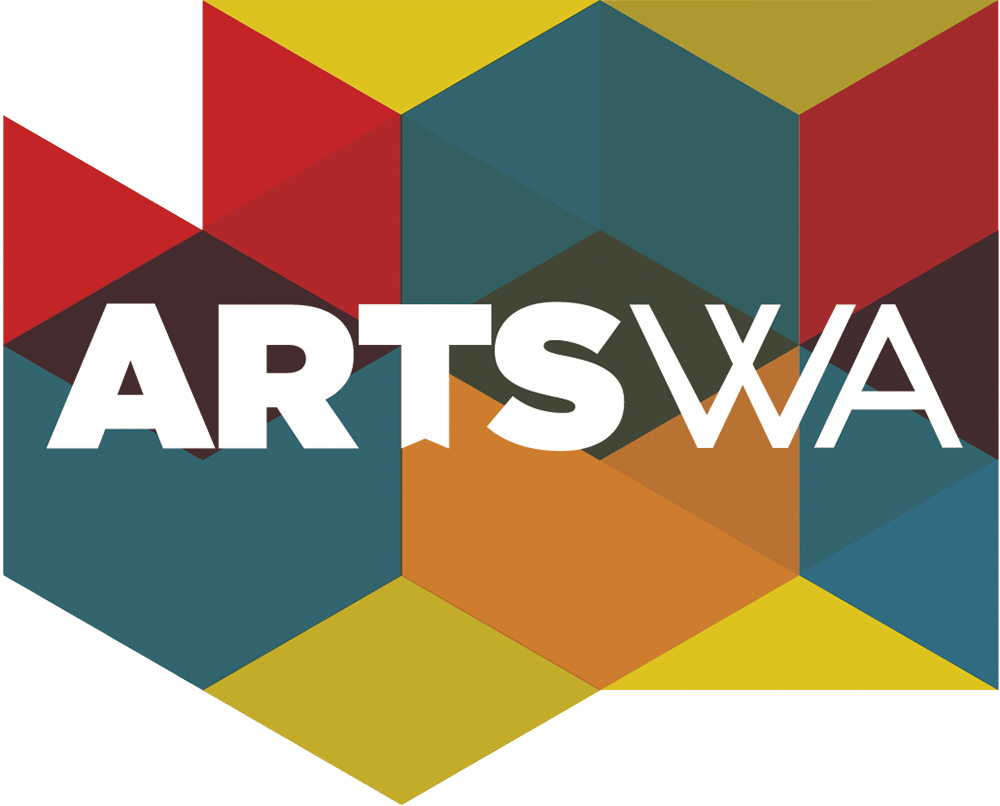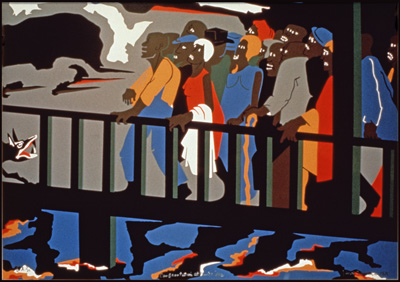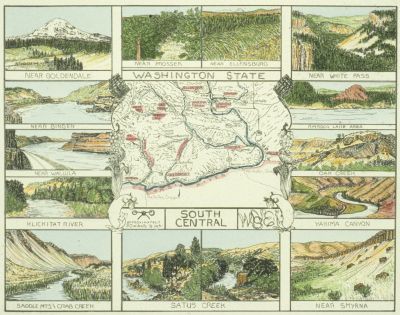Confrontation at the Bridge, 1975
Jacob Lawrence
(American, born 1917, died 2000)
Location: Olympic High School, Bremerton
ABOUT THE ARTWORK
Artist Jacob Lawrence's powerful Confrontation at the Bridge depicts the 1965 Selma to Montgomery marches for voting rights that would enable African Americans to register and vote without harassment.
Lawrence uses strong colors and expressive composition to highlight the strength and courage of the peaceful African-American marchers. They dominate the image with their forward movement. The unarmed marchers were confronted on the Edmund Pettus Bridge by state troopers who violently attacked and beat them. Lawrence clearly shows a mood of violence by the snarling dog, the dark sky, and the marchers’ worried faces. His choice to not show any state troopers is important and we know they are right there, just outside of the image. He focuses the artwork on the brave act of the African-American marchers who are taking (dangerous) action for their future.
The Selma to Montgomery marches were three protest marches in 1965 for voting rights and racial justice. The first march took place on March 7. State troopers and locals attacked the unarmed marchers with billy clubs and tear gas after they passed over the Edmund Pettus Bridge. Photos of the beaten and bloodied African-American marchers were seen around the world. The event became known as “Bloody Sunday”. The second march took place March 9. Troopers and marchers confronted each other at the bridge, but Martin Luther King Jr. led the marchers back to Selma. The third march started on March 21 after President Johnson committed to protecting the marchers with 1,900 members of the National Guard and FBI agents. Alabama Governor Wallace refused to do this. Over 25,000 people joined the marchers to the Alabama State Capitol in Montgomery, arriving on March 25. The Voting Rights Act became law on August 6, 1965.
This print was created by Jacob Lawrence when he was commissioned to produce a print to celebrate the United States' bicentennial in 1976.
This artwork was acquired for the State Art Collection in partnership with Central Kitsap School District.
ABOUT THE ARTIST
Celebrated artist Jacob Lawrence (1917-2000) created expressive, graphic artworks with a distinct style and color palette. His art explores the human condition, American history, and themes of social justice, especially as connects to the African American experience. Lawrence and his wife, artist Gwen Knight, had a life-long partnership of creative and critical guidance and support. About his own work, Lawrence said "When the subject is strong, simplicity is the only way to treat it."
Lawrence began his art career during the Harlem Renaissance, in 1930s New York City. During World War II (1939-45), he was drafted into the United States Coast Guard. He served in a segregated regiment and as Coast Guard Artist. In 1941, he was the first African American artist to be represented in the collection of the Museum of Modern Art (MOMA) in New York City. He became an influential teacher across the country, including at Black Mountain College in North Carolina. He was Professor Emeritus (1970-1985) in the School of Art at the University of Washington in Seattle.
Lawrence's artworks are in the permanent collections of over 200 museums, including the Metropolitan Museum of Art, the Museum of Modern Art (MOMA), the National Gallery of Art in Washington D.C., and the White House Art Collection. He was honored with a Washington State Governor's Arts and Heritage Award in 1984. His artworks and legacy continue to inspire discussions about art, society, and social justice.
ARTWORK DETAILS
| Material Category | Work on paper - print |
| Medium | Serigraph print |
| Dimensions | 19 1/2 in x 25 7/8 in |
| ID Number | WSAC1991.003.000 |
| Acquisition Method | Direct purchase |
| Artist Location | Washington, United States |
Location Information
| Agency | Central Kitsap School District |
| Artwork Location | Olympic High School Library |
| WA County | Kitsap |
| Placement | Interior |
| Site Type | Public School |
| Address | 7070 Stampede Blvd. NW Bremerton, WA 98311 |
| Geo. Coordinates | 47.626660, -122.665226 |
| Before Visiting | Some artworks may be located in areas not accessible to the general public (especially in K-12 public schools). Consider contacting the site prior to a visit to ensure access. |
| Map |
Related











_Edited.jpg)
